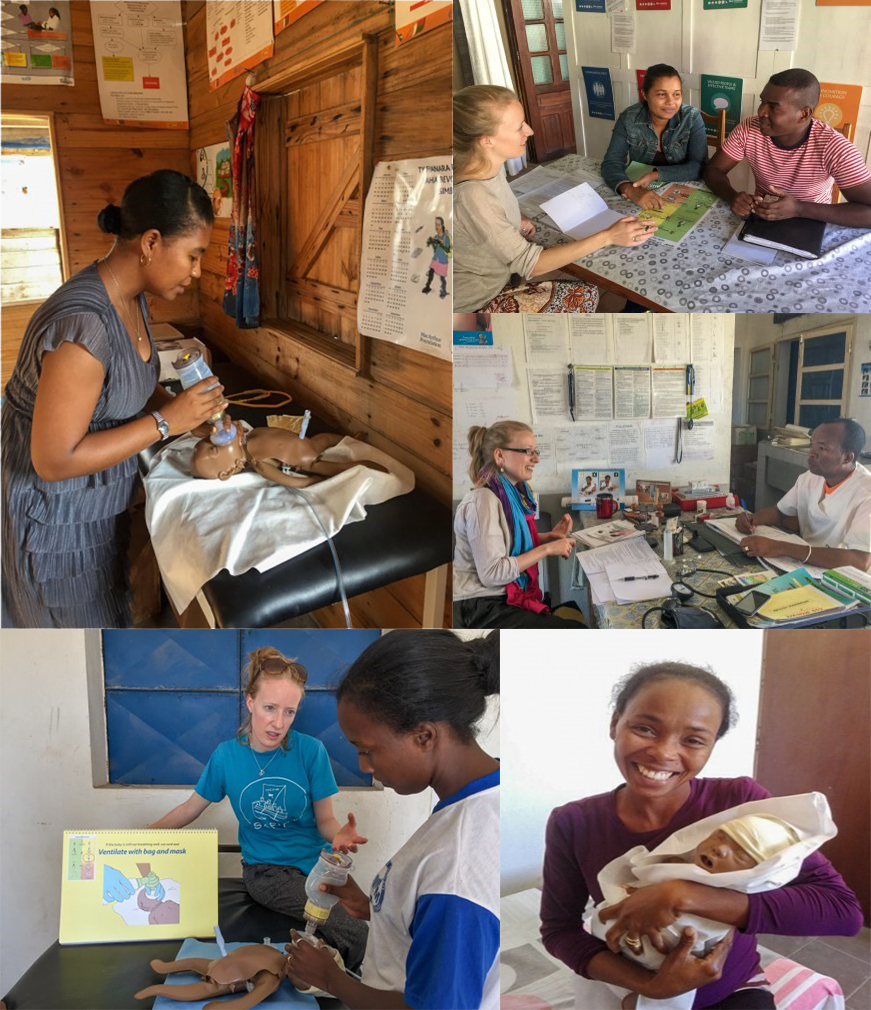This article is a cross-post from Blue Ventures , published August 3, 2017.
"Poussez, Madame Balbine!"
And so, the baby was born. The only noise, however, was the background cacophony of chickens, goats, and Malagasy music hits floating over the breeze. The sound of a baby crying was deafeningly absent. I looked around. The midwife was calm. All was under her control: "Don't worry, Madame Balbine". She dried the baby, changed the wet towel for a dry one, and then rubbed the baby's back several times. She quickly evaluated the baby – still no crying. She placed the baby down, next to the mother, and started helping the baby to breathe using a specialised bag-valve-mask device. After a few breaths, the piercing cry of a newborn broke the air. The midwife smiled, and handed a healthy, albeit slightly disgruntled, plastic baby over to mum. As she explained about skin-to-skin contact and breastfeeding, I ticked off the final points on my mark sheet.
We're back in Velondriake, the Locally Managed Marine Area in southwest Madagascar that is supported by Blue Ventures. This time, we're catching up with all of the Chefs CSB – the nurses or midwives who manage the public health centres (Centres de Santé de Base) in the area. They all successfully completed the Helping Babies Breathe course in August 2016 with Dr Alison Leaf and myself. This course provides lots of hands-on simulation training on evaluating a newborn baby, with a focus on the first minute of life. Babies who are not breathing must receive help within the "golden minute", in the form of ventilation with a bag-valve-mask. This is usually all that is needed to initiate the baby to breathe by itself. Between the one private midwife and five Chef CSBs, they've delivered over 200 babies since last August, and almost 15% of these babies needed ventilation.
They've delivered over 200 babies since last August, and almost 15% of these babies needed ventilation.
Neonatal resuscitation has become a new activity for the Safidy community health programme (Safidy means "the freedom to choose" in Malagasy), which is an integral part of Blue Ventures' holistic approach to conservation, combining community-based reproductive and other health services with locally-led marine resource management initiatives. Historically, Safidy has worked closely with Community Health Workers (CHWs) who provide basic healthcare services to rural communities. Now Safidy is also focusing on improving training and coverage of neonatal resuscitation in public health centres – not only to contribute to strengthening the government health system, but also to encourage CHW referrals for pregnant women to give birth in health facilities rather than their homes.
As a result, a well-weathered black Nissan 4×4 became home for the week. Together, the Safidy team and I overcame the sand tracks, rocky coastal roads, and spiny forest to visit the remote health centres, one by one. The most turquoise sea that you’ll ever see lined the route to Belavenoke. Lush green mangroves awaited us in Befandefa. Bulbous baobab trees, overflowing at the waist and meagre at their zenith, speckled the landscape as we bounced along the sandy roads. The blue and white signs announcing the presence of a Centre de Santé de Base, Niveau I (public health centre) quickly became familiar. We were invited into a small clinic room, with promotional posters of mosquito nets and condoms. A large blue fridge hummed in the background, protecting its precious cargo of polio and tuberculosis vaccinations. We were shown around: a lone delivery bed stood proud, in the centre of an otherwise bare salle d’accouchement (delivery room).
The nurses and midwives work here alone, each responsible for the health of those in their village, and neighbouring villages. By visiting them in their place of work, the centre did not have to close for the day. Indeed, we were interrupted as patients arrived and the Chef CSB rushed off to manage a fever; a bleeding umbilical cord; a follow up from the previous week. The Chefs reflected that they had used the skills we had taught them previously, but, with low numbers of deliveries each month, they were worried they might get out of practice.
What are Safidy project coordinators for if not to act out the role of expectant mothers during the refresher training? Both "Madame" Nicholas and "Madame" Njaka did a sterling job of encapsulating the essence of being heavily pregnant. Madame Balbine also gave several Oscar-worthy performances, but, with two X chromosomes, the role may have been a bit easier for her! We spent an enjoyable few hours – and I promise the Chefs CSB enjoyed it too – revising the actions to be taken at birth, until it had been committed to muscle memory. A short test later, with skills renewed and confidence improved, we said a loud and hearty veloma (goodbye) and it was on to the next CSB.
It's been a busy week, as you might imagine! We leave, happy in the knowledge that babies delivered by these nurses and midwives will be given the support they need. I have so much respect for everyone we've worked with this week, doing alone what we do as a team in the UK. I would like to thank them all for being so inviting, and for their continued enthusiasm. Misaotra bevata, amanarake koa! (Thank you, and until next time!)






Last Updated
11/15/2021
Source
American Academy of Pediatrics